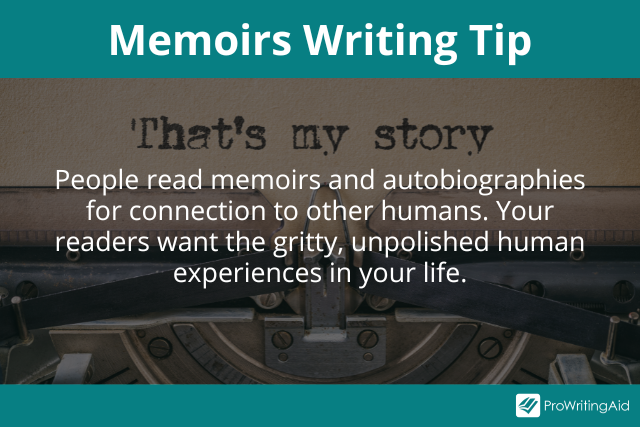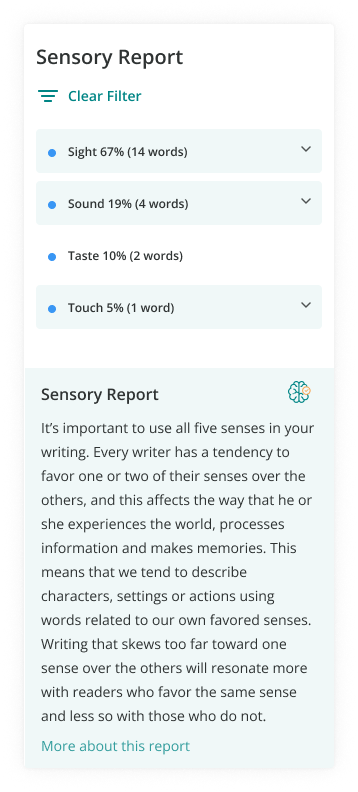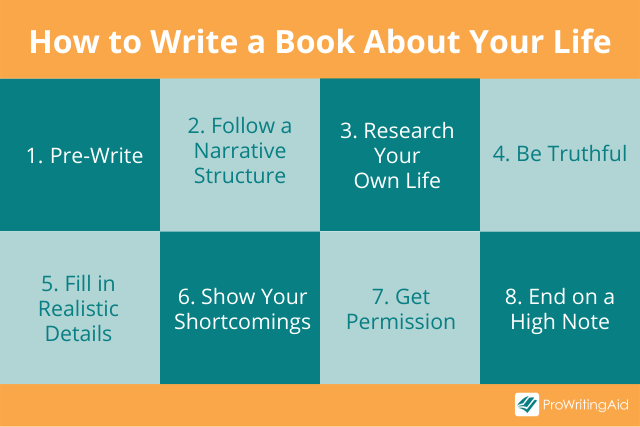
Everyone has a story to tell. But some people have an amazing life story that deserves to be shared with the world.
If you’ve ever thought about writing an autobiography or memoir, but you aren’t sure where to start, you’ve come to the right place. Today, we’re taking a deep dive into how to write a book about your life.
Before we get started, let’s clarify what we mean by autobiography and memoir. An autobiography is a book about your entire life story, chronologically from birth until present. The prefix “auto” means “self,” so it’s a self biography.
On the other hand, a memoir focuses on a specific part of your life story or a theme within your life.
For example, someone might write a memoir about teaching in an inner-city school. The book will only focus on stories related to that topic rather than on the teacher’s childhood.
Now that we understand the difference between autobiographies and memoirs, we can explore why and how to write a book about your life story.
Reasons to Write Your Story
Why might you write a book about your life? There are many reasons, and we bet your life has some interesting stories you can tell.
People might choose to write an autobiography if they’ve had an unusual or non-traditional life. Maybe they grew up in a cult or lived with nomads. Perhaps they had famous parents or lived their whole life in a war zone.
But other people have a specific theme or period in their life that makes a great memoir. They might have done something extraordinary or overcome a specific hardship.
Maybe they have a scandalous true story in their past that readers would find fascinating, or perhaps they have learned some inspirational truths from a unique challenge they want to share.
There is no shortage of reasons why someone might choose to share their life’s story with the world. Topics of memoirs and autobiographies are endless.
If you have a story where you’ve learned something worth sharing, or you have a particularly fascinating life, then you have a great reason to write a book about your life.
Some Examples of Autobiographies and Memoirs
Are you still not convinced you should write a book?
Let’s check out some great examples of autobiographical writing to inspire you.

Narrative of the Life of Frederick Douglass, an American Slave, by Frederick Douglass
One of the most famous examples of an autobiography comes from abolitionist Frederick Douglass. Douglass was born into slavery in 1818. He recounts his childhood and early life in slavery, his escape to freedom, and his activism.
It’s a passionate, often graphic, story of his courage and dedication to achieving a better life for himself and other Black people in 19th century America.
An Autobiography by Agatha Christie
As one of the most influential mystery writers of all time, Agatha Christie led her own fascinating and mysterious life. She was a deeply private person—and even disappeared for a time.
She wrote her autobiography before her death, but it was released posthumously. It still doesn’t talk about what happened during her disappearance, though: she kept some things a mystery.
Open: An Autobiography by Andre Agassi
Tennis legend Andre Agassi has led a fascinating and sometimes tragic life.
In this book, he recounts his early tennis training and troubled childhood, his rise to fame in the tennis world, his fraught relationships with Barbara Streisand and Brooke Shields, and his comeback at the 1999 French Open. It’s a vulnerable account of his life as an iconic athlete.
Bossypants by Tina Fey
Writer and comedian Tina Fey’s memoir topped the bestseller charts upon its release. Fey shares tidbits from her life, including childhood memories and parts of her early career.
She focuses on themes of societal expectations for women and girls and using humor to navigate the toughest parts of life. It’s a witty and poignant read that resonates with many of her female fans.
Me Talk Pretty One Day by David Sedaris
David Sedaris is one of the most popular memoirists. His most famous book, Me Talk Pretty One Day, is a collection of humorous but honest essays that recount his life growing up as a queer man and later moving to France with his partner and not speaking the language.
It’s a laugh-out-loud read of self-deprecating humor about a man learning to navigate life.
Somebody’s Daughter by Ashley C. Ford
Not all memoirs are comedic. Ashley C. Ford narrates her life through her impoverished and tumultuous childhood and dark adolescence.
The entire story is told through the lens of wanting to know her imprisoned father while not knowing why he is incarcerated. She searches for familial love and her identity as a Black woman in this gritty, emotional, no-filter memoir.
How to Start Writing a Book About Your Life
The first step in learning how to write a book about your life is to find your starting point. But where do you begin? You have a whole life full of interesting stories.
The first step is to start with a basic chronology. Make a timeline of your life. If you’ve already selected a topic or theme, focus on elements in your life that support that topic. These might be the lead-up to an event, the event itself, or the aftermath.
You might also talk about events that shaped your character or taught you a lesson you needed for this theme.
If you haven’t picked an overall theme, or you want to write an autobiography instead of a memoir, make a timeline of your entire life thus far. Start with the biggest events that stand out to you. Make it as detailed as possible.
Then look for underlying themes and messages. You are still writing a book, after all, and all books need themes.
Maybe the theme is healing from childhood trauma or showing the value of hard work and dedication. It might be focused on how relationships changed you or what you've learned from repeated poor decisions.
As you study your life, you’ll notice patterns. These patterns will help shape the overall narrative of your life story.
8 Tips on Writing a Book About Your Life
When it comes to how to write a book about your life, there’s no one correct way to do it. But there are tips you can use to guide you as you start writing.
You will write about hard, often dark, things in a book about your life. Writing your life story can be healing, but if revisiting past trauma is too overwhelming, please reach out to a professional or someone you trust for help. Your book can wait.
Once you are ready to start writing your life story, here are eight tips to help you along the way.

1. Pre-Write
The process of writing notes or brainstorming before writing a book is called pre-writing. Pre-writing is a great way to get started with autobiographical writing. You’ve lived a rich life full of many events. It can be hard to organize your thoughts.
Spend some time free writing about your life. Free writing is a way to sit down and let the words flow. There’s no structure or prompt. Avoid the urge to edit your pre-writing.
Once you start writing, you’ll find that you have a lot more material to write about than you previously thought.
When you free write, you’re following the path that your mind takes, and you might be surprised about some of the connections your subconscious makes between events and people.
Pre-writing is a learning opportunity for yourself, and it’s also a method that lets your brain begin to organize its life story in a way that makes sense to you.
Don’t judge your pre-writing. Instead, sit with the messages and lessons you discover in the process.
2. Follow a Narrative Structure
A person’s life doesn’t really follow a perfect story arc. However, when you’re writing a memoir or autobiography, you do need to follow basic story structure.
Let’s review what a basic story structure is. A story always includes an introduction, rising action, climax, falling action, and a resolution. Stories also need characters, settings, and conflicts.
While your life is much messier than a simple story structure, the elements of a story are there. Look for natural transitions in your life: beginnings, high and low points, and endings. You can turn these into a narrative structure for your book.
Characters are also important but much easier to find. You are the protagonist of your life story.
You may not have a clear antagonist depending on your personal story, but you will have supporting characters in the people who are close to you or you’ve interacted with. Paint them as multi-dimensional characters, not just props in your story.
In every story or personal event you include in your book, highlight the conflict and how you overcame it.
This applies to both serious and funny events. Think of each of the important moments as a scene. There should be a problem and a conflict within each.
3. Research Your Own Life
Research is an important part of every type of writing, and autobiographical writing is no different. Just because you lived it doesn’t mean you get to skip this step.
You can write things as you remember them, but you’ll probably find yourself fuzzy on the details. So, you can approach your own life like a journalist.
Find old pictures and diaries. Interview people you know for their recollections of the events you’re writing about.
You might also need to look at newspapers or other primary sources for backstory and setting details.
For example, if you participated in a sporting event in college, but you don’t remember when it happened or who the opposing team was, you can look through school newspapers.
Research will probably also remind you of things you’ve forgotten that will fit well in your book. It may provide you with a fresh perspective you didn’t have when the events occurred.
When you’re telling any sort of true story, the details matter. To be as factual as possible, research is key.
4. Be Truthful
People read memoirs and autobiographies for truth. When you set out to write a true story, you have an ethical responsibility to actually tell the truth.
Do not lie about what happened. Do not embellish to make things more interesting. Someone will discover you lied, and this will hurt your credibility as an author.
If you choose to include a story and you’re fuzzy on the facts, be honest about that. Say that in your recollection, this is how it happened.
If you find you want to lie to make your story interesting, start the process over. Ask yourself if this is really the spin on your life you should take. Find a story in your life that doesn’t make you want to lie.
5. Fill in Realistic Details
For most people, our memories are not video recordings. But how do you fill in details without embellishing?
When you write a story about your own life, you get some creative license in the details. You want to fill in details in a way that “could have been true.”
For example, you probably don’t remember what your brother was wearing on a random day 20 years ago. But if you remember how your brother dressed at that time, you can describe a likely wardrobe choice.
What would have been playing on the TV or radio in the background? What was a dinner your mother served regularly? Use pictures from your research and get input from others.
Writing accurate dialogue also uses this method of probable facts. You don’t have to recall word for word what was said. But think about how each person spoke. Did they have phrases they used often? Did they have interesting mannerisms during conversations?
Details are what bring your story to life. Use the five senses when describing events.
It doesn’t matter if you were eating McDonald’s or Burger King at the moment that changed your life. But you can describe the greasy burger you probably ate and the sound of screaming children at the next table.
ProWritingAid’s Sensory Report can help you find where you’ve included strong sensory detail and where you need more. Use this report to highlight your sensory language. Take notice if you’ve overused one sense, so you can include others when you edit.

6. Show Your Shortcomings
Writing a book about your life requires a high degree of vulnerability. Of course, we want people to think well of us when they finish the book. But painting yourself as an infallible protagonist isn’t honest.
People are messy. We fail; we make mistakes; we say things we shouldn’t have. Sometimes we’re the bad guy.
People read memoirs and autobiographies for connection to other humans. Your readers want the gritty, unpolished human experiences in your life. They’ll trust you as an author much more if you’re honest about your shortcomings.
It’s how you overcame your setbacks and mistakes that makes you an interesting person. Readers want to see your failures so they can root for you to succeed. They will find inspiration in your disappointments and missteps.

7. Get Permission
The last thing you want after you’ve published your book is a lawsuit. Because you’re writing a true story, there are some legal issues you need to consider.
Get permission to use the real names of people in your life. Be respectful and understanding if they don’t want to be in your book, even if that means editing out a particular memory.
You might also consider changing the names of places or businesses. If you paint a past job in a bad light, for example, you could get slapped with a defamation lawsuit.
Likewise, don’t use your book as a smear campaign. Every person’s story has two sides, even the people you don’t like. But libel and slander are real offenses with hefty consequences.
8. End on a High Note
Not every story has a happy ending, so we’re not suggesting you embellish a fairy tale ending. But people read memoirs and autobiographies for inspiration. They want true stories of people overcoming obstacles or defeating the odds.
Ending on a high note doesn’t mean happily ever after. It means ending with a reflection and a message for your readers.
In autobiographical writing, you want to end with the lessons you have learned from your own story. You’ve learned something about yourself or some universal truth through your life’s events. The end is when you share these tidbits.
What led you to write a book about your life? There’s a reason you sat down to share your story. In the conclusion, tie this together. Think about what you want readers to take away from your memories.
Conclusion on How to Write a Book About Your Life
The process of writing a book about your life is intense. It requires deep introspection and often sitting with some uncomfortable memories.
But it’s also a powerful process. You’ll learn that you have valuable knowledge and insights to share with the world.
As you begin writing, focus on the themes, messages, and universal truths. These make memoirs and autobiographies valuable and enjoyable to readers.
And always remember, you have a story worth telling.

